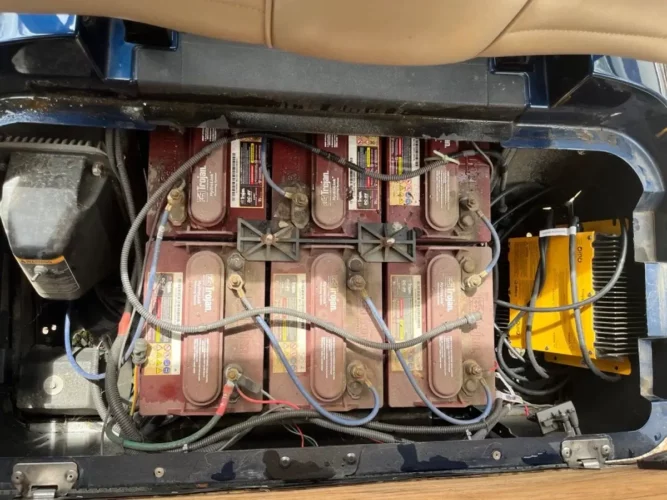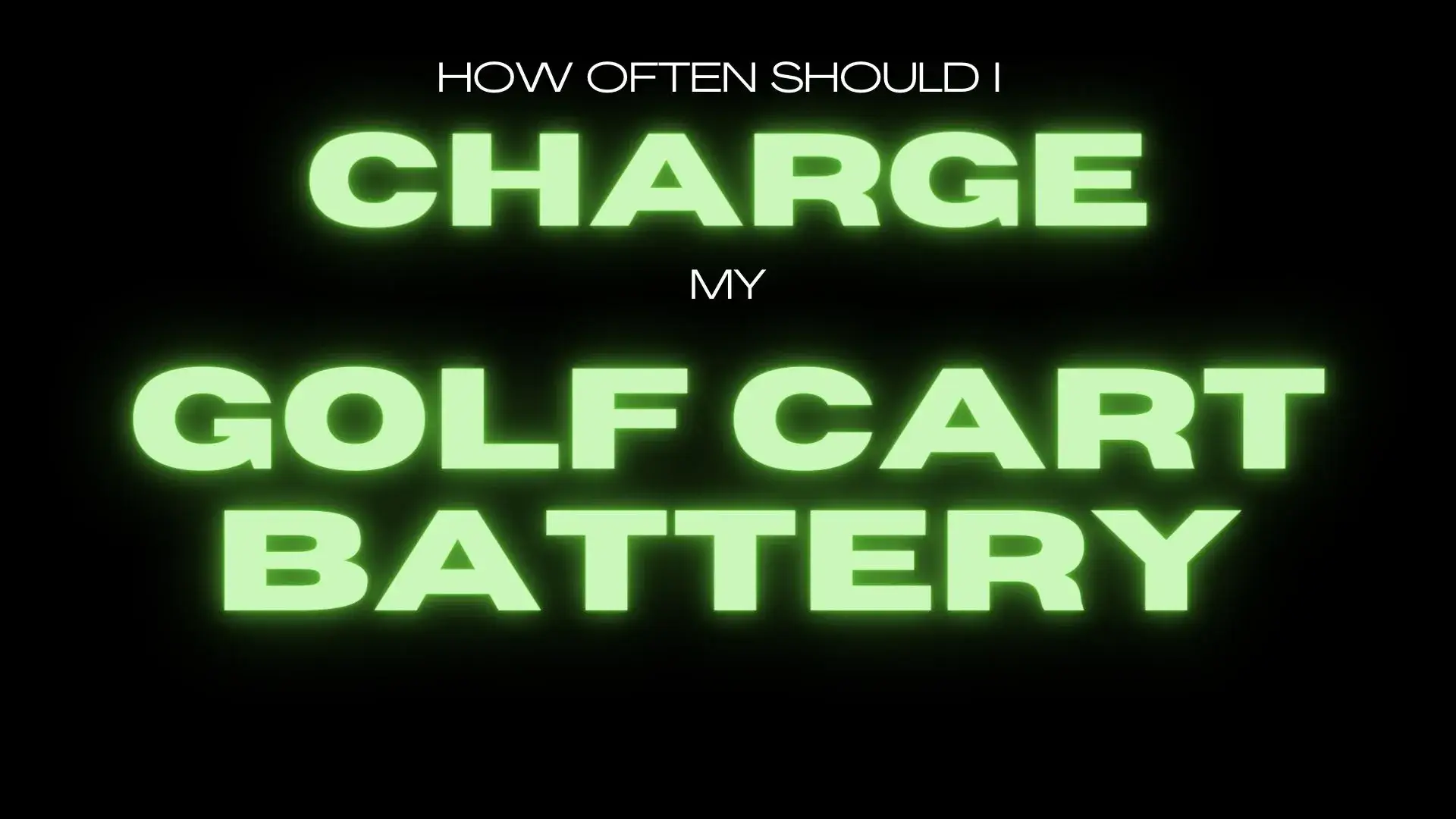Maximize your golf cart battery’s lifespan with our expert tips on how often to charge it. How often should I charge my golf cart batteries? Find Out Here.
Have you ever been out on the golf course, enjoying a beautiful day of golf, only to have your golf cart battery die on you halfway through your round?
It’s a frustrating experience that can ruin an otherwise perfect day.
That’s why we need to know how often we should charge our golf cart batteries. We can then avoid this situation altogether.
So, how often should you charge your golf cart batteries? The answer is between every use you should charge your golf cart batteries. Even after only ten minutes of use.
But, what about when you’re not using your golf cart? How often should you recharge your batteries then?
We’ll dive into the different storage scenarios that golf cart owners face. Then we give advice on how often to recharge your batteries in each scenario.
Whether you store your golf cart for the off-season or use it all the time, we’ve got you covered.
So, keep reading for everything you need to know to keep your golf cart batteries charged. We’ll keep them ready to go whenever you need them.
Don’t let a dead battery ruin your day on the course – read on to become a golf cart battery charging expert.
- Charge golf cart batteries after every use for maximum battery life
- Both lead-acid and lithium-ion batteries require regular charging
- Avoid deep discharge to prevent damage and reducing your battery lifespan
Table of Contents
How Often Should I Charge My Golf Cart Batteries?
Let’s take a look.
After Every Use
Many golf courses have their own golf carts available for member use. They recharge them after each use. A round usually lasts 4-5 hours and covers 3-4 miles. But a cart can go up to 6 miles, depending on the load. So a full charge is essential before each use to cut the chances of the battery failing mid-round.
Every 45-60 Days
So that’s best practice if you are a frequent user of your cart. But what if you have put your cart into storage for the cold season?
Or you only play on special occasions.
If you don’t have a power outlet near your cart in storage, you still need to charge the batteries every 45-60 days.
If you don’t have access to mains electricity, you will need to bring power to the cart or vice versa.
Options include an extra-long extension cord or driving the cart out of storage to a socket. I have a pal who uses a portable generator, connected to his battery charger, to give his golf cart battery a boost every few weeks.
And in hotter climates, like Arizona or Florida, the battery needs charging more often.
Use a Battery Maintainer
On the other hand, if you have a power outlet nearby, you are on easy street!
Using a battery maintainer is a great option. It keeps your golf cart batteries topped up without overcharging them.
The device uses sensors to detect when the battery falls below 100 percent charge. It then kicks into gear and keeps the battery topped up.
Its auto-shutoff stops charging when the battery is full. So it’s ideal for keeping your battery healthy through inactivity or storage.
And it’s safe to leave it plugged in without worrying about remembering to switch off.
Use A Golf Cart Battery Charger
The other option is investing in a golf battery charger designed for golf cart batteries. And I mean a full charger that has you covered in ALL situations, not only a maintainer.
These often have auto shut-off features to prevent overcharging. They ensure the batteries are charged to the correct voltage.
You can leave them on all the time to keep the charge at 100 percent. But if you prefer, you have the option to boost your battery every 45-60 days.
Onboard Chargers
Onboard chargers are more complicated to install, and you may need to enlist a pro to get these fitted to your cart.
Although installation is a bug, it means that you have a fitted charger wherever you go. This can be super convenient and a real time saver.
Portable Chargers
For installation, portable chargers are a simpler option. But do you want to lug one around with you wherever you go? Me neither. Which option you choose depends on your budget and circumstances.
When you pick your charger, consider whether you need a maintenance mode or not. It depends on whether you have to option to keep it plugged in or not.
But, most modern smart golf cart chargers have a maintenance option. So you can have the best of both and keep your options open.
Voltage
Using mismatched chargers is not an option. Voltage matters. If you have a 36 or 48-volt battery in your cart, you cannot use a 12-volt battery charger to charge it in situ.
You either need to match the voltage of the charger to that of the battery or vice versa.
If you like to keep things simple, match the voltage of the charger to the battery. Buy a charger with the appropriate voltage for your battery.
With a bigger budget and a need for flexibility, consider a variable voltage charger. This will have you covered if your needs change.
Using a mismatched charger
The other option is to take your battery apart and charge the sections individually. So, if you have a 36 or 48-volt battery you can split it into 12-volt “sections” and charge each with your 12-volt charger. Needless to say, this is a time-consuming hassle compared to having the right charger. But sometimes these things are necessary.
| Maintenance Task | Frequency |
|---|---|
| Check water level and add distilled water as needed | Monthly |
| Inspect battery terminals and cables, clean with a battery terminal cleaner if necessary | Monthly |
| Check battery voltage with a voltmeter and charge if voltage drops below 12.6 volts | Monthly |
| Charge the battery every 45-60 days to prevent sulfation and maintain charge | Every 45-60 days |
| Perform an equalization charge to balance the cells and extend battery life | Every 6 months |
| Perform a load test to check battery capacity and performance | Every 6 months |
| Fully charge the battery and disconnect it from the golf cart if not in use for an extended period of time | As needed |
| Replace the battery if it is damaged or shows signs of leakage | As needed |
Note: This is a sample maintenance schedule. Please refer to the manufacturer’s instructions and guidelines for specific maintenance requirements for your golf cart battery.
Why Charge My Golf Cart Battery So Often
Golf carts usually use deep cycle batteries, which differ from regular batteries. Recharging is key to avoiding reduced lifespan, slower speeds, and getting stranded on the golf course. In this section, we will discuss the reasons why frequent charging is necessary.
Deep Cycle Battery
There are two main types of lead-acid batteries. The first is the SLI (Starter, Lights, Ignition) battery that we use to start our gas vehicles. The second type is deep cycle batteries, often used in boats, RVS, and golf carts.
Deep cycle batteries are designed for repeated charges and deep discharges. Whereas SLI batteries provide short bursts of power with only a shallow discharge. This means golf cart batteries must be charged between uses. This maintains their capacity and function effectively.
If the deep cycle battery is diminished, there may not be the power there for your needs. This can cause slow operation, or in the worst cases, running out of power altogether.

Low Charge Means Reduced Lifespan
Keeping your golf cart battery at a low charge can impact its lifespan. Operating the battery in a low-charge state can cause its capacity to decrease over time. This will lead to reduced performance and a shorter life.
If you leave the battery below full charge for too long, lead sulfation will start. This is the build-up of lead sulfate crystals on the battery plates. These will reduce function and eventually kill a battery.
To extend the life of your golf cart battery, it’s important to charge it after every use, even for short trips.
Low Charge Means Slower Speed
A golf cart battery’s performance is related to its charge level. So, when the battery is low, the cart’s speed and performance may become compromised.
Regular charging means that it operates at peak speed and performance on the course.
Avoid Being Left Stranded
Having a dead or damaged battery can leave you stranded in the middle of the golf course. Frequent charges ensure you have enough range and power to complete your round.
No problem getting back for tea or something stronger.
Regular battery charging reduces the risk of battery damage, saving costly replacements.
How Often Should I Charge a Lithium Golf Cart Battery?

Lithium batteries are popular, last longer, charge faster, and need less maintenance. But how often should you charge these batteries to keep your golf cart running smoothly?
Ideally, you should still charge your lithium golf cart batteries after every use. Even if you only drove for a few minutes, doing so extends their lifespan and prevents loss of capacity. Keeping your batteries charged also ensures your golf cart is ready for its next trip.
One plus of lithium-ion batteries is that being in a discharged state won’t damage them in the same way as lead acid. But it is still best practice to keep them charged up as much as possible.
For those whose battery is not in constant use, charging at least once a month is essential. Don’t worry about charging time. Lithium golf cart batteries can fully recharge in as little as two hours.
An automatic charger makes the process even easier. Simply plug it in, and the charger takes care of the rest. It monitors the battery’s charge level and stops charging when it’s full. This handy feature prevents overcharging, increasing the life of your batteries.
So, remember to charge your lithium batteries after each use or at least once a month. Proper charging and a decent automatic charger will keep your battery in shape for years.
Factors Affecting Battery Life
There are a range of factors determining your battery’s lifespan. Here are a few.
Usage Frequency
The more often you use your golf cart, the sooner its battery will need charging. But it’s essential to charge batteries even after short trips. Consistent charging helps maximize battery life and performance.
Natural Discharge
All batteries, including golf cart ones, experience natural or self-discharge. This means they lose their charge over time, even when not in use. Checking your golf cart’s battery charge and keeping it topped off can help combat this issue.
Temperature
Temperature plays a big role in battery life. Lead-acid batteries, often used in golf carts, prefer temperate conditions. Extreme hot or cold temperatures can cause batteries to lose charge fast, or freeze. This will reduce their lifespan.
Charging Habits
Charging habits contribute to battery health and longevity. Using an automatic charger ensures that the battery won’t overcharge. And charging after every use helps prevent damage caused by low charge levels. It’s also important to use a high-quality charger designed for your battery type. This is whether it’s lead-acid or lithium, and depends on the voltage.
So pay attention to usage frequency, natural discharge, temperature, and charging habits. Proper care can help you avoid needing replacements and keep your golf cart at its best.
Tips for Maintaining Battery Health
The best way to ensure a long and happy life for your battery is to maintain it. Lithium-ion batteries are mostly maintenance-free. But lead acid batteries need a little more work.
Clean and Maintain Battery Terminals
Keeping your golf cart battery terminals clean is essential. Dirt and dust can accumulate on the terminals, reducing the battery’s efficiency. Always check for corrosion and clean corroded terminals when needed. This will ensure a proper power supply and maintain the golf cart’s ignition.
Regularly Top Up Water Levels
Check the water levels in your golf cart batteries and add distilled water if necessary. Always fill only up to submerge the plates. Do not overfill as this can cause the acid mixture to overflow and damage surrounding parts. Too high water levels can cause corrosion and shorten the battery’s lifespan.
Never allow the lead plates of the battery to be exposed to air as this may cause harm to the battery.
Keep Above 80%
Maintaining the battery capacity above 80% is crucial for golf cart batteries. Overcharging or letting the battery sit in a state of low charge can impact capacity.
By following these tips, golfers can focus on their game without battery concerns. So, remember to practice proper battery maintenance like you practice your golf swing.
Before You Go …
Version 1: Before you go, let me leave you with one last important tip. If you’re a golf cart owner, you know how crucial it is to keep your batteries charged. But what if you’re in a pinch and only have a 12-volt charger on hand?
Can you use it to charge your golf cart? This is a question that every golf cart owner should know the answer to. That’s why you need to read our next article “Can You Charge A Golf Cart With A 12-Volt Charger“.
Don’t risk damaging your batteries or your cart by using the wrong charger. Read our article and make sure you’re doing it right!
Frequently Asked Questions
Here’s the FAQs
How long does it take to fully charge golf cart batteries?
Charging time for golf cart batteries varies depending on factors like the battery type and charger. Typically, it takes around 8 to 10 hours to charge the batteries fully. Make a habit of charging them overnight for the best results. Note: This is only advisable if your charger has an auto-cutoff function.
Can golf cart batteries be overcharged?
Yes, overcharging golf cart batteries can lead to reduced battery life or damage. To prevent this, use a smart charger that automatically stops charging once the batteries are full.
Do I need to charge my golf cart batteries after each use?
It’s important to charge golf cart batteries after every use, even if it was just for a few minutes. This keeps the batteries in good condition and prolongs their life.
What are some tips for maintaining lithium golf cart batteries?
For lithium golf cart batteries, proper maintenance includes:
- Regularly checking battery connections to ensure they’re clean and tight.
- Protecting the batteries from extreme temperatures.
- Using the recommended charger for optimal charging.
- Avoiding overcharging.
How long can golf cart batteries be stored without charging?
Golf cart batteries can usually be stored for up to 30 days without charging. However, it’s best to charge them before storing them to maintain their capacity and avoid issues later on.
When is it time to replace golf cart batteries?
Signs that indicate it’s time to replace your golf cart batteries include:
- Batteries don’t hold a charge for long.
- Decreased driving range.
- Swollen or leaking batteries.
- The cart struggles to go uphill or accelerate.
Regularly monitoring the condition of your golf cart batteries helps you know when it’s time for a replacement.
Related Articles
- Can You Charge A Golf Cart With A 12-Volt Charger? Don’t Try It Before Reading This Guide!
- How Long Can A Golf Cart Battery Last On One Charge? Rev Up Your Ride With These Simple Steps
- How Long Does a Golf Cart Battery Charger Last? Don’t Let a Low-Quality Charger HOLD You Back!
- How to Test Golf Cart Battery Chargers: 12 Steps You Need to Know to Keep Your Cart on the Green!


